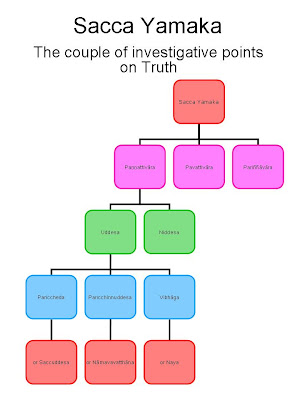Padasodhanamūlacakkavāro
(Anuloma)
3. Dukkhaṃ dukkhasaccanti: āmantā. Saccā samudayasaccanti: samudayasaccaṃ saccañceva samudayasaccañca. Avasesā saccā, na samudayasaccaṃ.
Dukkhaṃ dukkhasaccanti: āmantā. Saccā nirodhasaccanti: -pe- saccā maggasaccanti: maggasaccaṃ saccañceva maggasaccañca. Avasesā saccā, na maggasaccaṃ.
| Structure of Padasodhanamūlacakkavāra | |
| Base | Reverse order style (Paṭiloma) |
| 1. Dukkhaṃ dukkhasaccanti | 2. Saccā samudaya saccanti |
| 3. Saccā nirodhasaccanti | |
| 4. Saccā maggasaccanti | |
| 2. Samudayo samudayasaccanti | 1. Saccā dukkhasaccanti |
| 3. Saccā nirodhasaccanti | |
| 4. Saccā maggasaccanti | |
| 3. Nirodho nirodhasaccanti | 1. Saccā dukkhasaccanti |
| 2. Saccā samudayasaccanti | |
| 4. Saccā maggasaccanti | |
| 4. Maggo maggasaccanti | 1. Saccā dukkhasaccanti |
| 2. Saccā samudayasaccanti | |
| 3. Saccā nirodhasaccanti | |
Guide:
Extract in full Pali text of Padasodhanamūlacakkavāro (Anuloma):
Dukkhaṃ dukkhasaccanti: āmantā.
Saccā samudayasaccanti: samudayasaccaṃ saccañceva samudayasaccañca. Avasesā saccā, na samudayasaccaṃ.
Dukkhaṃ dukkhasaccanti: āmantā.
Saccā nirodhasaccanti: nirodhasaccaṃ saccañceva nirodhasaccañca. Avasesā saccā, na nirodhasaccaṃ.
Dukkhaṃ dukkhasaccanti: āmantā.
Saccā maggasaccanti: maggasaccaṃ saccañceva maggasaccañca. Avasesā saccā, na maggasaccaṃ.
Listen to the Dhamma talks:
1. 081108c08-padasodhanamulacakkavara.mp3
